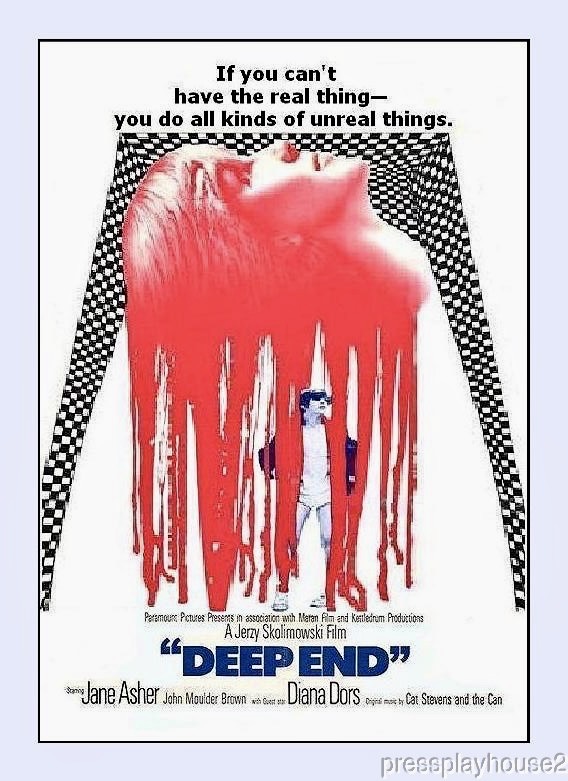
Sometimes a film comes along that no marketing department can get a handle on and as a result it just gets tossed out there to fend for itself and to find an audience on its own. That was the case with Deep End, made in 1970 but released in 1971 by Paramount Pictures to selected art houses and whatever theaters were willing to book it. I saw the film at the Westhampton Theatre in Richmond, Virginia, which was obviously run by an Anglophile because almost any new British film would play there. Of course, Deep End is only British on the surface. It is set in London but the cast includes British, Germany actors and Polish actors and much of the film was shot in Munich, Germany by Polish director Jerzy Skolimowski.

It was the second English language film for Skolimowski, who first attracted attention for co-writing the screenplay of Knife in the Water (1962) with director Roman Polanski. Deep End also had no big name stars in the cast and mainly featured relatively unknown actors with the possible exception of former British sex bomb Diana Dors and Jane Asher, whose main claim to fame at that point was having the dubious distinction of being Paul McCartney’s ex-fiancee (they had been together five years and split up in 1968).

The tagline for the Deep End film poster proclaimed “If you can’t have the real thing – you do all kinds of unreal things” over an image of a teenage schoolboy ensnared in the long flowing hair of a red-headed woman. In some ways, the publicists weren’t too far off the mark but this approach couldn’t begin to convey the quirky and inspired movie hiding behind the ad. On the surface, it looked like another coming-of-age film and it did play off some of the clichés of that well-worn genre. But it is much trickier, darker and weird but also unexpectedly funny with an absurdist streak.

First, a little background on how the film came to be made. Skolimowski was a screenwriter, actor and director who fled Poland after his experimental feature Hands Up! (Rece do Gory) was censored by the Communist-controlled film board in 1967. The film didn’t get an official release until 14 years later in 1981 but, in the meantime, the director made Le Depart in Paris in 1967 with Jean-Pierre Leaud as a hairdresser’s apprentice obsessed with car racing. Then Skolimowski got the opportunity to direct the big-budget historical satire, The Adventures of Gerald (1970), which was based on short stories by Arthur Conan Doyle. It was shot outside Rome with an international cast that included Claudia Cardinale, Peter McEnery, Eli Wallach, Ivan Desny and Jack Hawkins but Skolimowski considers it his worst film.

It was while he was editing The Adventures of Gerald in London that he got an idea for a new film which involved two unrelated incidents; one involved a couple that lost a diamond in the snow and the other concerned a mysterious death in a bathhouse. With the contributions of two Polish film associates, writer/director Jerzy Gruza and Boleslaw Sulik, Skolimowski turned out a screenplay called Starting Out which attracted the attention of producer Judd Bernard (Point Blank) and soon he had a deal to make his movie. But there was a catch – most of it had be shot in Munich, Germany for budgetary reasons with some additional scenes to be filmed in London.
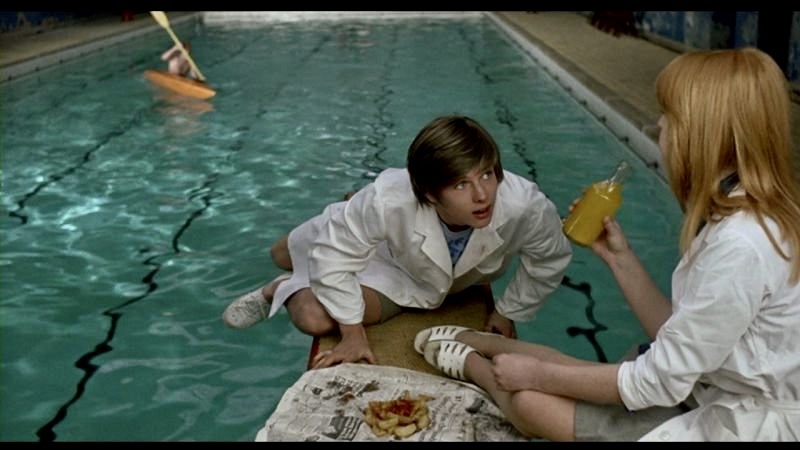
Retitled Deep End, the movie utilized interiors from the Mullersches Volksbad bath house in Munich (the corridors and dressing rooms) plus a local nightclub, cinema and public park. The London locations included the main swimming pool (Cathall Baths in East London) and the Soho sequences, which were filmed in the neighborhood of Walker’s Court. Under such circumstances with cast and crew members flying back and forth between Munich and London on a rushed film shoot, you might expect an incongruous mess but Deep End is a remarkably seamless and unpredictable wonder that creates its own sense of reality.

Set in a run-down bathhouse in a working class borough of London, Deep End introduces us to a fifteen year old boy named Mike (John Moulder-Brown) on his first day at work there as an attendant to the clients. Showing him the ropes of the trade is Susan (Jane Asher), a provocative and sexy 23-year-old employee who has a fiancé (Christopher Sandford) and is also having an affair with Mike’s former gym teacher (Karl Michael Vogler), who appears to have a thing for under-age schoolgirls. In this strangely cloistered environment Mike’s fantasy life runs wild, obviously encouraged by his observation of some of the regular clients, including an overweight blonde with a football fetish (Diana Dors in one of the film’s more bizarre and hilarious sequences).

At first Deep End maintains a playful balance between reality and fantasy but as Mike’s sexual obsession with Susan begins to grow the sense of real and unreal become entwined until you can’t tell the dancers from the dance. Skolimowski switches emotional gears often and effortlessly from amusement to angst to tenderness to tragedy without losing credibility or momentum. It is this very quality that divided the critics when it first premiered in the U.S. The ending, in particular, disturbed and angered many but if you are paying attention the road signs are there marking the way. It is not, after all, a coming-of-age film in any ordinary sense but a black comedy about the fears and fantasies of an adolescent male, one whose virginity and expectations of losing it are more troubling to him than we could ever imagine.

Below are just a few of the varied responses Deep End received from many of the best known critics at the time, starting with the positive reviews:
“Jerzy Skolimowski has finally put it all together in Deep End: passion without hysteria, intelligence without derision, and compassion without special pleading. Deep End is the best of Godard, Truffaut, and Polanski, and then some; nothing less, in fact, than a work of genius on the two tracks of cinema, the visual and the psychological.” – Andrew Sarris, The Village Voice
Skolimowski has created a masterpiece, a picture that freezes the smile on your face…Without uttering a word of social protest as such, Skolimowski has created an impassioned denunciation of society’s evils…Before that chilling moment of truth, Deep End is a very funny film.” – Kevin Thomas, Los Angeles Times
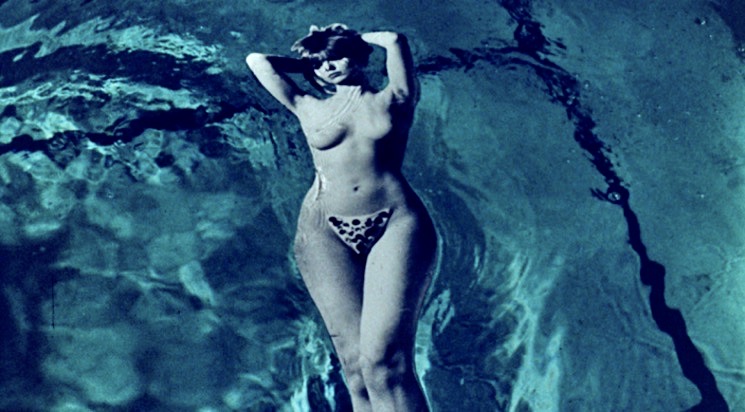
“John Moulder-Brown and Jane Asher – They take a vision that had been sober, fateful and heavily ironic and help render it alert, subtle, graceful and sensitive.” – Roger Greenspun, The New York Times
“A canny black comedy, executed with a surrealistic flourish…transforms the rite of puberty into a frenzied and often wildly funny vaudeville.” – Jay Cocks, Time
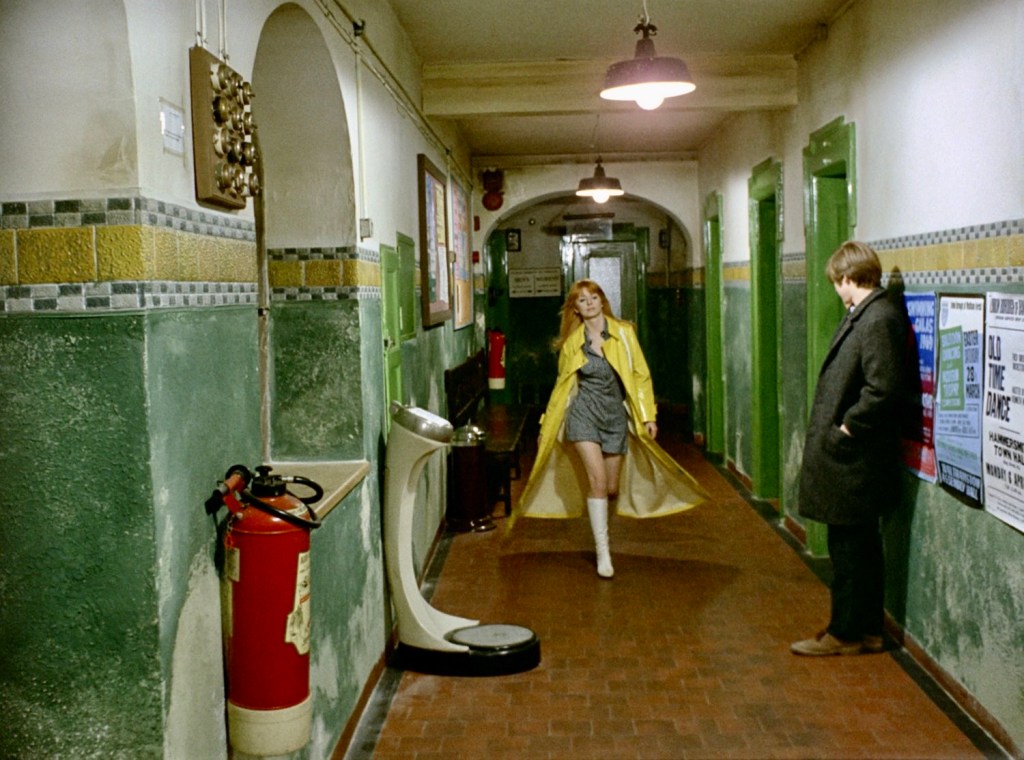
Then there were the negative notices:
“Deep End seems likeable and promising until it begins to drift, morbidly and irreversibly, off the deep end. I think the final result is rather weird and loathsome…Judging from Deep End, Skolimowski has a fairly distinctive personality, but it happens to be a split personality, split in a way – half-Truffaut, half-Polanski – that I find rather disconcerting and unappealing.” – Gary Arnold, The Washington Post
“A pop-psych tragedy…basically pointless and shallow – a demonstration of artlessness imitating lifelessness.” – Arthur Cooper, Newsweek

“..as clumsily contrived to provide visual thrills as ever any corny old melodrama was contrived to provide chase thrills…The symbolism of the bathhouse is patent; so are the colors. We even see walls being painted red as the passions hot up. (The idea of Red Desert trivialized into Red Dessert.)” – Stanley Kauffmann, The New Republic
“Skolimowski mistakes artiness for artistry.” – Hollis Alpert, The Saturday Review.

And there you have it. For me, Deep End remains as fresh and inventive as any of the French New Wave films of the early sixties but has never enjoyed the reputation or following of films like Breathless or The 400 Blows. Part of the film’s contemporary feel is due to the cinematography of Charlie Steinberger, who shot most of Deep End with a hand-held camera, creating this live, you-are-there immediacy. The art direction of Anthony Pratt (the nephew of Boris Karloff!) and Max Ott Jr. is also instrumental in setting up a slightly surreal hot house atmosphere through colors that pop. Note the sequence where Jane Asher and the bath house cashier (Erica Beer) squabble while a painter in the background begins covering the drab green wall with bright red paint.

Skolimowski obviously had fun adding playful scenes here and there such as the sequence inside the adult movie theater which is showing a “sex education” film from Sweden. The director created this mini-movie in black and white and it is an amusing parody of the sort of exploitation films that were popular in the late sixties like Language of Love (1969) or Sexual Freedom in Denmark (1970). Skolimowski even shows up in a Hitchcock-like cameo as a man reading a communist newspaper in a subway car.
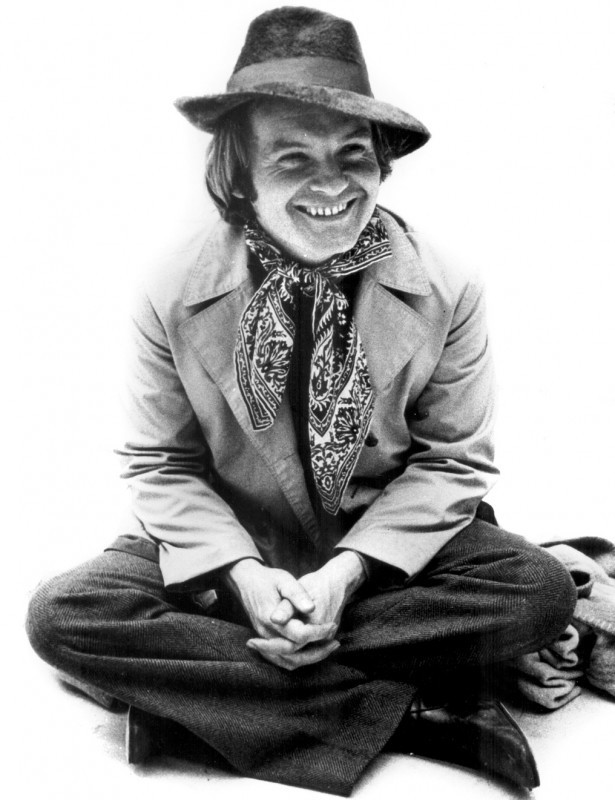
The only things that betray the film’s age are superficial details – the hair styles and fashions of the early seventies plus a music score that features a theme song by Cat Stevens (“But I Might Die Tonight”) and one by Can, “Mother Sky.” Deep End presented the first use of a Cat Stevens song in movies and by the time the singer/songwriter’s music for Harold and Maude appeared a year later he was always a top-selling mainstream artisit. As for “Mother Sky,” it provides the hypnotic beat over one of the film’s most riveting sequences, a Soho nightlife prowl with John Moulder-Brown stealing a nude cardboard standee and encountering a Chinese hot dog vendor (played by Burt Kwouk of the Peter Sellers/Pink Panther series fame) and a bed-ridden prostitute wearing a full leg cast rigged to a pulley.

Last but not least are the subtle but complex performances of both Jane Asher and John Moulder-Brown who continue to work in films and television today but are rarely singled out for their excellence or fascinating filmographies. Jane Asher had been a child actress and was memorable in such films as Crash of Silence (1952), her screen debut, and The Quatermass Xperiment aka The Creeping Unknown (1955). She continued to work in film and television through her teenage years – she had a leading role opposite Vincent Price in Roger Corman’s The Masque of the Red Death (1964) – and begin to emerge as a leading lady over the next decade with such films as Alfie (1966), The Winter’s Tale (1967) and Henry VIII and His Six Wives (1972) as Jane Seymour. She also became a successful novelist and started a bakery/cake decorating business that thrived for 25 years and earned her the moniker “The Queen of Cakes. But for me, Deep End is her crowning achievement. The scene where she unloads years of rage at her gym teacher lover and completely annihilates him emotionally is almost exhilarating. And he deserves it because he is basically a pedophile who preys on underage schoolgirls like Susan once was.
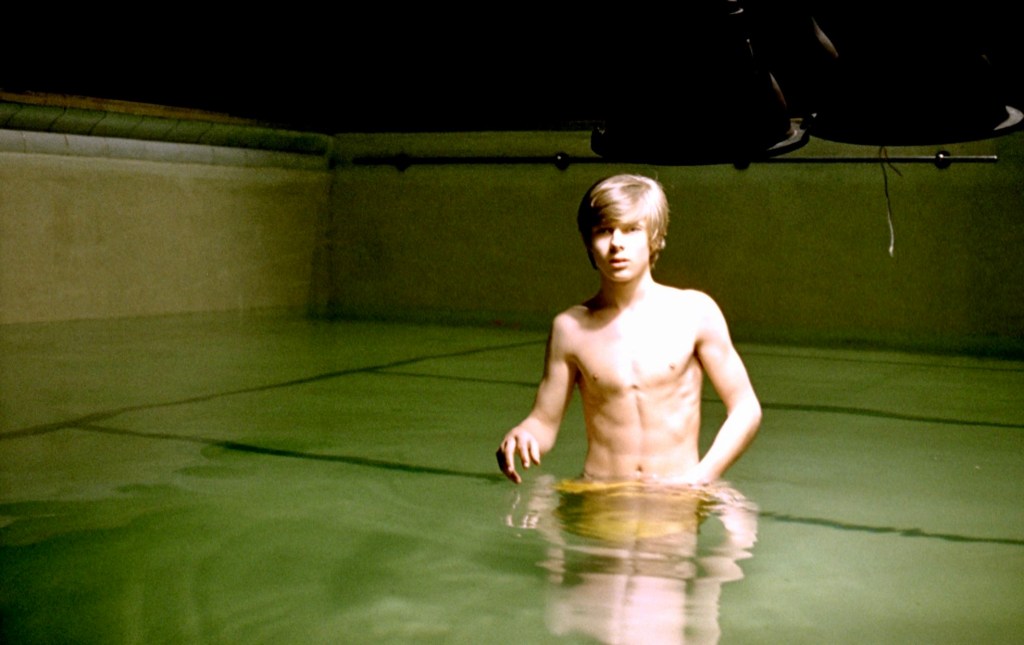
Like Asher, John Moulder-Brown was also a child actor (Room at the Top, Becket) but he is best known by horror film buffs as the deceptively innocent hero of Narciso Ibanez Serrador’s La Residencia aka The House That Screamed (1969) and for the Hammer horror fave, Vampire Circus (1972). He is also quite good as a hitchhiker who becomes trapped with his female companion in an isolated mansion run by a sadist in Eloy de la Iglesia’s Forbidden Love Game (1975). Strangely enough, in the film he made prior to this, First Love (1970), an adaptation of a novel by Russian author Ivan Turgenev and Maximilian Schell’s directorial debut, Moulder-Brown is also cast as a teenage boy involved with an older woman (Dominique Sanda) in a story that ends tragically.
Sad to say, Deep End is unavailable in any format in the U.S. but in 2011 the BFI Flipside label released the film on DVD and Blu-ray in a glorious remastered edition that came with several extra features including a documentary on the making of the film and Careless Love, a 1976 film short about a doomed relationship starring Jane Asher. If you own an all-region DVD/Blu-ray player, you can still find copies of this available through the BFI Flipside store.
Other links of interest:
https://culture.pl/en/artist/jerzy-skolimowski
https://www.cineaste.com/spring2016/to-be-aesthetic-and-not-boring-jerzy-skolimowski
https://www.zomboscloset.com/zombos_closet_of_horror_b/2014/12/interview-john-moulder-brown.html
https://www.yours.co.uk/leisure/celebrity-tv/diana-dors-life-love-and-fur-bikinis/


